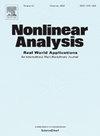Local bifurcation structure for a free boundary problem modeling tumor growth
IF 1.8
3区 数学
Q1 MATHEMATICS, APPLIED
引用次数: 0
Abstract
There are many papers in the literature studying a classic free boundary problem modeling 3-dimensional tumor growth, initiated by Byrne and Chaplain. One of the most important parameters is the tumor aggressiveness constant . Friedman and Reitich (1999) showed the problem admits a unique radially symmetric solution with the free boundary when the external nutrient concentration is greater than the threshold concentration for proliferation. A sequence of papers, Fontelos and Friedman (2003), Friedman and Hu (2008) and Pan and Xing (2022) derived a sequence of symmetry-breaking branches bifurcating from the spherical state at an increasing sequence of (). Friedman and Hu (2008) studied the structure of the branching solution at . These bifurcation results cover only the direction of spherical harmonic function . In this paper, we determine a plethora of new local bifurcation structures at for even in directions involving combinations of for .
模拟肿瘤生长的自由边界问题的局部分岔结构
文献中有许多论文研究了由Byrne和Chaplain提出的三维肿瘤生长的经典自由边界问题。其中最重要的参数是肿瘤侵袭常数μ。Friedman和Reitich(1999)表明,当外部营养物质浓度大于增殖阈值浓度时,该问题存在唯一的径向对称解,其自由边界为r=RS。Fontelos和Friedman(2003)、Friedman和Hu(2008)以及Pan和Xing(2022)等一系列论文推导出了一个从球态r=RS出发,以μ=μn (n≥2)递增的序列分叉的对称破坏分支序列。Friedman和Hu(2008)研究了μ=μ2时分支解的结构。这些分岔结果只覆盖了球调和函数y2,0的方向。在本文中,我们确定了在μ=μn处,当n≥2时,在涉及Yn,m的组合的方向上,当m≠0时,在μ=μn处存在大量新的局部分岔结构。
本文章由计算机程序翻译,如有差异,请以英文原文为准。
求助全文
约1分钟内获得全文
求助全文
来源期刊
CiteScore
3.80
自引率
5.00%
发文量
176
审稿时长
59 days
期刊介绍:
Nonlinear Analysis: Real World Applications welcomes all research articles of the highest quality with special emphasis on applying techniques of nonlinear analysis to model and to treat nonlinear phenomena with which nature confronts us. Coverage of applications includes any branch of science and technology such as solid and fluid mechanics, material science, mathematical biology and chemistry, control theory, and inverse problems.
The aim of Nonlinear Analysis: Real World Applications is to publish articles which are predominantly devoted to employing methods and techniques from analysis, including partial differential equations, functional analysis, dynamical systems and evolution equations, calculus of variations, and bifurcations theory.

 求助内容:
求助内容: 应助结果提醒方式:
应助结果提醒方式:


